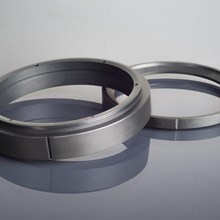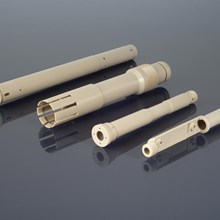We were tasked with the manufacture of a fluoropolymer semiconductor product. This consisted of a ceramic or silica insert which was to be fully encapsulated with a non-wetting fluoropolymer, that could then be machined into a burr-free component with an exceptional finish.
The second development criteria was the finished component had to be completely burr-free. The machining tolerances also had to be to an exceptional standard for a plastic component.
Finally, the encapsulation of the insert was to be consistent all around the part with no variation in wall thickness to ensure that there was no thinner area of fluoropolymer, which could form a weak point, or failure area.
HOW WE APPROACHED THE PROJECT
Selection of Dyneon TFM by AFT Fluorotec ensured that the fluoropolymer was easy to machine and also able to achieve the exceptional finish required for the application.
The Dyneon TFM would be chemically resistant and could be used at the required operating temperatures around 160 degrees centigrade. The Dyneon TFM also offered an exceptional barrier to permeation from chemicals over and above a standard PTFE material.
The manufacturing technique was developed over a period of time, and involved a moulding and stress relieving process. Several detailed turning and milling operations with careful checks on a coordinate measuring machine to ensure the cumulative positional tolerance of the part features were maintained.
THE EXTRA MILE
Once the part was produced to drawing, we had to develop an in-house process to remove the many burrs from the milling operation, and then ensure that the finished part was polished to an exceptional standard to ensure that there would be no areas where fluids could stick or pool on the surface of the finished component in its application.
The non-wetting properties of Dyneon TFM and fluoropolymers ensured the material behaved as designed once the part was burr-free and the required level of surface finish was achieved.




